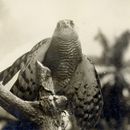en
names in breadcrumbs


Sitting on posts a few metres high repeatedly during consecutive days: regularly observed flying fast and low, e.g. over road, dyke, often in or near village (hunting chickens; entered house) and in plantations or secondary vegetation; observed hunting insects in trees; quite vocal (Louette & Herroelen 2007).
This secretive forest-inhabiting hawk is mostly seen either flying or sitting at low heights.
IUCN Red List Status: Least Concern (LC)
- Uncommon to scarce forest resident (Global Raptor Information Network 2011).
- One of the sympatric Accipiter species which are widespread in the Lower Guinea forest block (Louette & Herroelen 2007).
Saturated colours and heavy grey and brown barring below distinctive; A. castanilius is smaller, but longer-tailed than A. toussenelii (Kemp 1994).
West and Central Africa: from Nigeria to the Congo River basin (Kemp 1994).
Simulated distribution for the present (based on recent observed climate change), for 2025, 2055 and 2085 (based on projected future climate change) is available (BirdLife International and Durham University 2011) at: http://www.birdlife.org/datazone/speciesfactsheet.php?id=3424&m=2
A. castanilius does not belong to the African Goshawk group but is the most closely related sister species of the African Goshawk group tachiro/toussenelii (Breman et al. 2013).
Lowland tropical evergreen forest, sometimes extending into dense adjacent secondary growth (Kemp 1994) or even into plantations (Global Raptor Information Network 2011).
Adaptation to a life in dense forest or darker environment is suggested by its relatively large eyes and its proportionally broader skull in comparison with the African Goshawk population Accipiter tachiro/toussenelii (Louette& Herroelen 2007).
Apparently fairly close to A. toussenelii and A. tachiro, but distinguished by smaller size and long inner claw (Kemp 1994).
Identification features (Louette 2010):
- Adult:
Upperparts: blackish
Throat: white, finely streaked
Breast and belly: dirty white with bold blackish-brown bars (sometimes with chestnut traces)
Flanks: chestnut
Thighs: plain chestnut
Tail: blackish with 3-4 relatively large spots
Irides: usually red
Legs and feet: bright yellow with black cast
- Immature:
Upperparts: dark brown
Throat: white with central streak
Breast: heavily spotted
Belly: white with a variable amount of spots
Flanks: heavily streaked or barred
Thighs: barred with wider bars than toussenelii paraspecies
Legs and feet: yellow with black cast
Probably resident and sedentary (Kemp 1994).
Non-migratory, but juveniles disperse from breeding areas (Bildstein 2006 in Global Raptor Information Network 2011).
The global population size has not been quantified, but the species is described as common in larger tracts of forest (del Hoyo et al. 1992 in BirdLife International 2011).
Herroelen (2006) stated that the main breeding period for this species in the Democratic Republic of Congo is January-April. The breeding period in Gabon is also reported as January to April (Ferguson-Lees and Christie 2001 in Global Raptor Information Network 2011).
c. 30-35 cm (Kemp 1994).
Medium-sized, among the Central African forest-inhabiting hawks (Louette & Herroelen 2007).
The population is suspected to be in decline owing to ongoing habitat destruction (Ferguson-Lees and Christie 2001 in BirdLife International 2011).
It feeds on small vertebrates, including birds, reptiles, amphibians and mammals (Brosset 1973 in Global Raptor Information Network 2011), and invertebrates, such as grasshoppers and beetles (Louette and Herroelen 2007).
The chestnut-flanked sparrowhawk (Accipiter castanilius) is a small west African species of sparrowhawk in the family Accipitridae.
Chestnut-flanked sparrowhawk has blackish grey upperparts with a very distinctive pattern on the underparts; the breast and belly are heavily barred grey and brown, with chestnut colored flanks. The throat is white and the head is rather broad compared to similar species. The cere is yellow as is the thin eyering which surrounds the red eye. Females and juveniles are browner. They sit 25 cm (9.8 in) tall and have a wingspan of 60 cm (24 in).[3][4]
The chestnut-flanked sparrowhawk occurs in west central Africa from southern Nigeria through Cameroon and Gabon to Democratic Republic of Congo. It is said to occur in the Upper Guinean forests west of Nigeria but this has not been confirmed.[5]
The chestnut-flanked sparrowhawk is found mainly in lowland tropical rainforest, mainly in the middle storey but it can adapt to dense secondary growth and will approach habitation in the forest. It is found up to 750 m (2,460 ft) above sea level.[4]
The habits of the chestnut-flanked sparrowhawk are poorly known but it is known to lay eggs during January to April in Gabon. It probably feeds mainly on birds but has been recorded catching bats. As it is rarely seen in the open it is presumed to be a still hunter which sits in the cover of foliage and sallies out to catch prey. Has been known to enter houses after poultry and to follow driver ant columns to ambush the attendant small birds.[4]
Closely related to the African goshawk Accipiter tachiro and the red-chested goshawk Accipiter toussenelii, albeit smaller than either of those species. It is normally regarded as monotypic, although some authorities recognise the smaller birds in the Congo Basin as the subspecies Accipiter castanilius beniensis.[5]
The chestnut-flanked sparrowhawk (Accipiter castanilius) is a small west African species of sparrowhawk in the family Accipitridae.